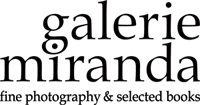16 April – 18 May 2024 : Process and picture
With experimental works by Ellen Carey, Chuck Kelton, Laura Letinsky, Thomas Ruff, Nancy Wilson-Pajic
For the third capsule show of its 6th anniversary cycle, Galerie Miranda brings together 5 major artists whose different practices explore and disrupt the fundamentals of the traditional photographic medium: the darkroom, the artist's gesture and the representative function. Chuck Kelton's abstract chemigrams resemble landscapes; Laura Letinsky's still lives are in fact meticulous compositions of found images, torn and collaged; Ellen Carey's Finitograms are ready-made unique works, unsigned and unfinished; and Thomas Ruff's digital photograms reinvent the traditional photogram, like those also on show by Nancy Wilson-Pajic, a pioneer in experimental photography in France.
CAREY, Ellen (1952, American)
Ellen Carey’s Finitogram project is a portfolio of light sensitive, 10x8 inch pictures of nothing that began in conditions like those in Carey’s sightless, color darkroom based in time, total darkness, and invisibility. These non-images are unpredictable as they change in palette and enlarge in form. As the chemical clock ticks, this new getting ready-to-be- made from its once unfinished state, by time and by light, unfolds, becomes Finitogram. The historic photogram re-named as ready-made adds to Carey’s handbook guide through photography’s nearly two centuries’ arc of light, photogram, colour and Polaroid. Photography Degree Zero (the artist's Polaroid practice) and Struck by Light (her darkroom practice) visually consult Talbot, Daguerre, and Anna Atkins, the powerhouse tripod of 19th century game changers. Talbot’s negative-to-positive duality of the photogram-as-image is doubled, while Daguerre is mirrored in the glossy polish of Polaroid’s pristine surface and crisp picture. Talbot’s soft-focus, non-color compositions in blurry outlines see light’s ‘shadow’ while Prussian blue sees colour-as-light transformed in Anna Atkins’ cyanotype images. Each of them used light with light-sensitive processes to create their images – all unique pictures, all-in-one totalities – originating visual impact for which the gestalt is c’est.
LETINSKY, Laura (1962, American)
Laura Letinksy creates delicate, meticulous tableaux that sublimate and honour the forgotten details of everyday domestic life. Her large-scale, carefully crafted scenes often focus on the remnants of a meal or party, as she plays with ideas about perception and the transformative qualities of the photograph. Her series Ill Form & Void Full (2010-2014), explores the tension between material and image, as Letinsky extracts elements from already existing imagery in magazines of food and domestic wares, calling attention to the constructed nature of all photographs.
Works presented in friendly collaboration with Yancey Richardson Gallery
KELTON, Chuck (1952, American)
Chuck Kelton makes unique, camera-less photographs, working in full daylight outside of the darkroom and spending weeks, sometimes months, sketching and preparing each work. A master printer, Kelton is also a passionate collector of photographs, practical manuals and tools from the history of photography. He explores 19th century techniques and chemistry such as gold chloride and selenium, that he combines with bleach and developer to coax a lush palette of colours from light sensitive, traditional silver gelatin papers. Describing his approach as "calligraphy with chemistry", Chuck Kelton combines chemogram and photogram techniques: the image in a photogram is the result of exposing photographic paper to light — writing with light — whereas the image in a chemogram is the outcome of exposing photographic paper to developer and fixer — writing with chemistry. Kelton often folds the paper in two - a trangressive act in photography - creating a visual break that is understood by the viewer as a horizon line creating depth of field in the artist's misty palette.
RUFF, Thomas (1958, German)
In a series of abstract works that he started making in 2012, the photographer Thomas Ruff has explored technical and aesthetic aspects of the photogram. A process based on the same photochemistry that underlies analog photography, the photogram had its heyday in the modernist era, when László Moholy-Nagy and others created abstract black-and- white assemblages. Ruff has now brought this cameraless technique into the 21st century, building a virtual darkroom and using a 3D program to aggregate diverse objects such as rods, lenses, and paper in manifold constellations. The software also lets him enhance the compositions in digital space with colored lighting. What we see is a polychrome play of shadows, refracted light, and the silhouettes of objects.In appropriating a traditional photographic technique and aesthetic, Ruff at once deconstructs them, harnessing the potentials of cutting-edge digital image processing to make his own rules and manipulating new parameters to achieve a drastic enlargement of the range of creative possibilities.
WILSON-PAJIC, Nancy (1941, France-USA)
After a first chapter of her artistic career with the New York avant garde of the 1960s, in 1978 Nancy Wilson-Pajic moved to Paris where she began exploring the representative character of photography in relation to text and other forms of information, “My work is concerned with the processes by which information accumulates and is transformed – by juxtaposition with other information, by memory, and by the individual’s order of priorities. I have used sound recordings and written text, video and film, photographs, drawings and computer technologies — in installations, in book form and on the wall — to create mental spaces within which creative reflection may take place.” Her early experiments with traditional photographic processes such as gum bichromate, carbon transfer, photogram, cyanotype, established Nancy Wilson-Pajic as a precursor of the artists’ photography movement.
PROCESS&PICTURE_Press Release




